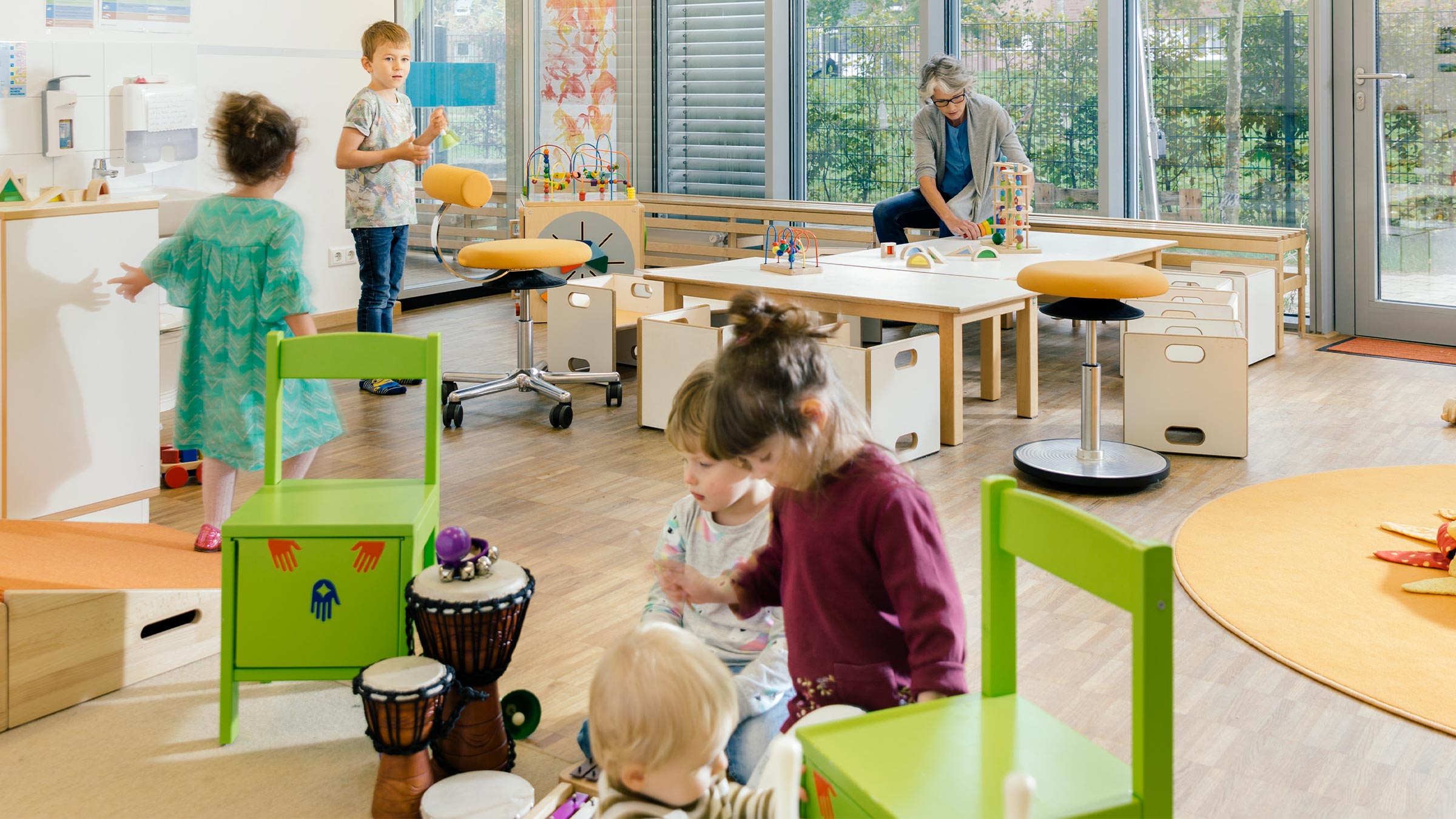Eight years ago, D&G Excavating started a side business providing child care. The Lynd, Minnesota, construction firm found it difficult to hire enough workers, especially younger workers, and the owners thought offering child care as a perk would make D&G more appealing.
What they found was that starting a child care business is also difficult.
Heather Willert, the firm’s safety coordinator and the person assigned to lead the child care effort, remembers one early challenge.
“When we first started doing it, I actually filled out the entirely wrong application,” she said. “It was probably a 40- to 80-hour time period worth of work that was for nothing because we had to turn around and fill out a different application.”
Over the past three years, as demand for workers heated up even more, many other employers have come to appreciate how significant a barrier the lack of child care can be to workers accepting employment or showing up as scheduled. But despite talk of employers providing child care for their workers, few have done so.
Becoming a child care provider, they have found, has its own barriers.
Suzanne Pearl, Minnesota director for First Children’s Finance, which provides advice and loans to child care businesses, said employers sometimes ask her what it takes to start a child care service. When she tells them about the regulations and other barriers, she said they usually decide against starting a service themselves.
Few employers offer child care
There are currently around 8,000 licensed child care providers in Minnesota with a total licensed capacity to care for more than 221,000 children, according to state licensing data. The state tracks some employer-sponsored providers but not all. The Minneapolis Fed informally counted 42 such child care programs with a total licensed capacity of 2,700, including those tracked by the state.
Most are longstanding child care programs. Sixty percent have had active licenses for more than 10 years. Only five programs were started in the past three years, when discussions of employer-sponsored child care intensified.
For a program to count as employer-sponsored, there has to be some indication that it offers preferential treatment to employees of a firm whose primary business isn’t child care. A vast majority of providers were not counted because their licensing data suggests child care is their primary business, for example, small in-home providers and child care chains not located on a corporate campus. For the remaining license holders, the Minneapolis Fed examined recruitment materials, economic reports, and even news reports to look for indications the program is employer-sponsored.
Thirty-six of the employer-sponsored programs were, like the one at D&G, started by the employer. Most of the rest are programs run by outside child care providers on behalf of the employer. These tend to be larger programs with a capacity for more than 100 children and sponsored by larger employers such as Land O’Lakes and Allianz. They’re also more difficult to track because their licenses offer few clues, other than their address, that they may be employer-sponsored.
Outside providers usually require many children in their programs for adequate cash flow, so they’re unlikely to work with any but the largest employers, according to Pearl. All outside providers counted by the Minneapolis Fed were sponsored by major employers located in larger cities.
Among smaller employers with in-house programs, the most common are health care and social assistance businesses, which include hospitals and nursing homes. Hospitals, with their female-dominated workforces, have long embraced employer-sponsored child care. During the pandemic, even more hospitals started child care programs, including one in Minnesota.
River’s Edge Hospital in St. Peter said it started a temporary child care program in 2020 out of concern for its essential workers’ ability to come to work. The program proved so popular that the hospital made it permanent in 2021 and added a new license just for infants and toddlers.
Nursing homes also employ a female-dominated workforce, and some do offer child care to employees. But the purpose of child care for these businesses is to enhance the lives of their residents; interacting with children is believed to reduce feelings of isolation in nursing home residents.
Other common programs include universities, which have long hosted child care programs that serve as training grounds for educators; schools, which offer child care to serve parents; and manufacturers. Some manufacturers, such as Taylor Corp. in Mankato, said many of their women employees work shifts outside normal hours for most child care providers. Most public schools were not counted because their child care programs are exempt from state licensing.
Barriers to care
One reason there aren’t more employer-sponsored providers in Minnesota is that it’s hard to enter an industry with as many rules and regulations as child care. With the health and well-being of children on the line, these regulations tend to be complex in most states, some more than others.
But the bureaucracy doesn’t end there. Because very thin margins are common in the industry, providers often depend on state subsidies, each of which has a variety of requirements.
At D&G, Willert said one of the initial struggles was figuring out what type of license made sense for the firm. The simplest kind of licenses are those for in-home child care, but D&G’s child care would have to operate out of a commercial space. Requirements for child care centers, which do allow the use of commercial space, are much more restrictive. D&G eventually settled on a then-new special license that allows employers to use a similar license to an in-home provider but in a commercial space. It was so new even the regional licensor wasn’t familiar with it, which led to Willert filling out the wrong form.
After D&G figured out the budget for its child care service, she said, it learned it wouldn’t qualify for state food subsidies for in-home providers because, even though it followed the same rules as in-home providers, the subsidies only apply to providers located in buildings that are zoned residential. That meant D&G had to take a “financial hit,” one that it’s still dealing with today, she said.
Another barrier is financial risk. The gap between what it costs to provide care and what parents can afford is slim, given the relatively small student-teacher ratio required by the state, especially for the youngest children, according to Pearl. “We always say you lose money on infants, you break even on toddlers, you make your profit on older kids,” she said, which means providers must always balance just the right mix of kids to earn even a slim margin.
Many providers, including D&G, found they couldn’t just rely on their pool of employees alone and have opened up their child care services to the community.
And hiring is a significant barrier for child care providers, too. Surveys conducted by the Minneapolis Fed and First Children’s Finance have found that many child care providers struggle to pay enough to attract workers who can earn more at fast food restaurants. Employer-sponsored child care providers would likely struggle with this in addition to the hiring difficulties that would’ve prompted them to provide child care in the first place.
Once employers learn more about the intricacies of child care, especially the regulations, that they or their staff would have to take time to master, Pearl said, the response is often, “Oh, yeah, no, I don’t really want to be an expert. I don’t want anybody on my staff to need to be an expert in what the sleeping and napping arrangements need to look like.”
Minnesota employers aren’t alone. A recent U.S. General Accounting Office report found that the barriers of cost and complexity are likely preventing many employers nationwide from sponsoring child care programs, despite the availability of federal tax incentives.
Employer motivation
So why do some employers choose to sponsor these programs anyway?
Many say they want to appeal to job applicants and to help their employees avoid missing work due to child care issues. But other employers share the same concerns about the impact of a child care shortage on their workforce without going as far as starting a child care program of their own. At D&G Excavating, the idea came from co-owner Kristin Gruhot, according to Willert. During a brainstorming session to figure out what to do about employee absenteeism, they realized that lack of child care was a key factor. Gruhot decided a child care program had to be in the mix of options.
D&G was “founded on family principles,” Willert said, and that’s why the owners felt taking care of employees’ children was important.
They opened Lil’ Diggers Daycare in 2015. Willert hesitated to call it a success, at least in the sense that D&G has seen a return on its investment. That will probably take time, she said, as younger workers with children replace older workers who don’t require child care.
But maybe return on investment isn’t even the point.
Willert said other employers considering in-house child care programs should consider their “core value.” Starting a program would be a good option if the goal is to be family-friendly, she said, but not if the goal is to profit.
Tu-Uyen Tran is the senior writer in the Minneapolis Fed’s Public Affairs department. He specializes in deeply reported, data-driven articles. Before joining the Bank in 2018, Tu-Uyen was an editor and reporter in Fargo, Grand Forks, and Seattle.






